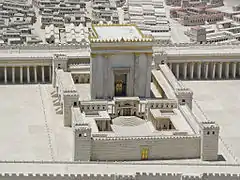Holyland Model of Jerusalem
The Holyland Model of Jerusalem, also known as Model of Jerusalem at the end of the Second Temple period (Hebrew: דגם ירושלים בסוף ימי בית שני) is a 1:50 scale model of the city of Jerusalem in the late Second Temple period. The model was moved from its original location at the Holyland Hotel in Bayit VeGan, Jerusalem, to a new site at the Israel Museum in June 2006.[1]

History

The model, measuring 2,000 square metres (22,000 sq ft), was commissioned in 1966 by the banker Hans Kroch, the owner of the Holyland Hotel, in memory of his son, Yaakov, an IDF soldier who was killed in the 1947–1949 Palestine war in 1948. The model was designed by Israeli historian and geographer Michael Avi-Yonah based on the writings of Flavius Josephus and other historical sources. The model includes a replica of the Herodian Temple. From 1974, Yoram Tsafrir (1938-2015) superintended the Holyland Model of Jerusalem.[2]
In 2006, the model was relocated to the southern edge of the Billy Rose Sculpture Garden at the Israel Museum. In preparation for the move, the model was sawn into 100 pieces and later reassembled. The Holyland Hotel spent $3.5 million on the move.[1]
Notable depictions
The Jerusalem model features a number of notable and important structures,[3] as the model was based on the writings of Josephus at the time of its construction. Since then some modifications have been made to the model- such as the removal of the Hippodrome.
Districts
The city was divided into a number of districts,[3] listed as follows.
- City of David
- Upper City
- Lower City
- Bezetha
- Ophel
Notable structures
Following is a list of notable structures that are depicted in the Holyland Model of Jerusalem
- Temple Mount: the model depicts the Temple Mount and the Herodian Temple during the first century CE, the trail offers the view of the Temple Mount from the east.
- Pool of Bethesda
- Pool of Siloam
- Notable Towers: Mariamne Tower, Phasael Tower, Hippicus Tower
- Herod's Palace
- The Upper Market
- Herod's Theatre
- Hippodrome (now removed from the model)
- Monument of King Alexander Jannaeus
- Tomb of Huldah
- Antonia Fortress
- Tomb of King David
- Fish Gate: It was located somewhere near (probably eastwards) the modern Damascus Gate, close to the fish market. It is also believed to have been mentioned in the Book of Nehemiah.
- Psephenus Tower: It was located on the north-western corner of the third wall of Jerusalem.
References
- "Rock of our existence". Archived from the original on February 11, 2007. Retrieved 2009-08-16.CS1 maint: bot: original URL status unknown (link)
- Wharton, Annabel Jane (15 August 2006). Selling Jerusalem: Relics, Replicas, Theme Parks. University of Chicago Press. pp. 220–. ISBN 978-0-226-89422-5. Retrieved 14 April 2013.
- "Holyland Model of Jerusalem". Madain Project. Retrieved 14 May 2019.
Further reading
- Balakirsky Katz, Maya (17 January 2011). "Avi Yonah's Model Of Second Temple Jerusalem And The Development Of Israeli Visual Culture". In Steven Fine (ed.). The Temple of Jerusalem: From Moses to the Messiah: In Honor of Professor Louis H. Feldman. BRILL. doi:10.1163/ej.9789004192539.i-405.75. ISBN 978-90-04-21471-2.CS1 maint: ref=harv (link)
External links
| Wikimedia Commons has media related to Holyland Model of Jerusalem. |
- Israeli museum website
- Pictorial compendium of The Holyland Model of First Century Jerusalem with location identifiers